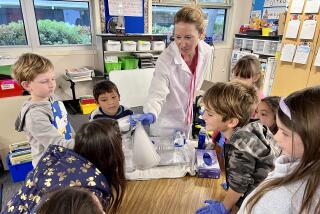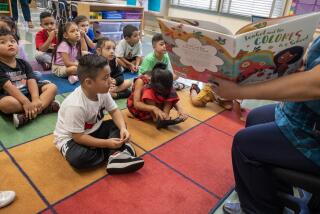Classroom Computers Can Help--If Properly Used
- Share via
As public schools rush to install computers and plug classrooms into the Internet, skeptics have often asked whether all the time and money spent on new technology will lead to higher student achievement.
New research on mathematics instruction and test scores offers an encouraging answer: yes, when the technology is used effectively by trained teachers. But there is a major caveat: If used the wrong way, computers can drag down student achievement.
The findings, made public Tuesday in a special report by the newspaper Education Week, are the first to link higher test scores nationwide to classroom computer use, while accounting for other factors such as poverty, teacher experience and class size.
Analyzing 1996 math scores for fourth- and eighth-graders on the National Assessment of Educational Progress, a multiple-choice test given in most states, researcher Harold Wenglinsky uncovered two noteworthy trends.
* Students whose teachers had received some kind of computer training within the last five years performed better than those whose teachers had not. Fourth-graders were slightly ahead and eighth-graders were months ahead.
Fortunately, most teachers are getting at least minimal computer training. In California, at least four in five teachers surveyed had been trained, about the national average. But the survey did not touch on the depth or the quality of training.
* Eighth-graders got a major boost when their teachers used computers mainly for sophisticated problem solving, such as examining variables in algebraic equations or using spreadsheets to manipulate data. And fourth-graders benefited somewhat when their teachers used computers mainly for math learning games. But when teachers used computers mainly for math drills, eighth-graders’ scores plunged more than half a grade level, and fourth-graders showed no gain.
Unfortunately, the survey found, only 29% of eighth-graders in California and 27% nationwide were getting the kind of math instruction from computers that pays dividends. There are also racial inequities. White students are more likely than black students to learn problem solving through computers; black students are more likely than white students to use computers for math drills.
The research “shows the tremendous potential that technology has. There are ways to get really striking gains,” said Wenglinsky, an associate research scientist for the Educational Testing Service. “But it also provides a real caution”--namely, that machines can be put to good educational use, or they can be misused.
*
While educators push for more teacher training, the nation’s investment in computer hardware and software has grown dramatically. The Education Week report “Technology Counts” found that three in four public school classrooms have at least one computer at hand for instruction.
Those machines are not all outdated hand-me-downs. Forty-five percent of the computers in public schools have a CD-ROM drive and the capacity to generate sounds--which are crucial for running the latest, multimedia software. What’s more, 44% of classrooms are now wired to the Internet, according to figures the newspaper obtained from Market Data Retrieval in Connecticut. A federal survey in 1994 found that only 3% of classrooms were connected.
How does California stack up? The percentage of classrooms in the state with instructional computers and the percentage with Internet access mirror the national averages. But the state lags by other measures. There are 18 students for every multimedia computer in California, the data show, compared with 13 nationwide, and 16 students in California per CD-ROM drive, compared to 12 nationwide.
The state’s most publicized computer initiative, “Digital High School,” entered its second year this month. A lottery was used to select 315 high schools to receive $136 million in technology grants, including 12 in the Los Angeles Unified School District. The program aims to upgrade technology in all high schools statewide over four years. Selected schools are required to apply for the grant and find local matching funds.
Oddly enough, not all eligible schools have done that. Of 216 high schools selected last year, only 121 have applied, said Doug Stone, spokesman for the state Department of Education. The 95 schools that failed to apply, he said, “are missing a golden opportunity.”






